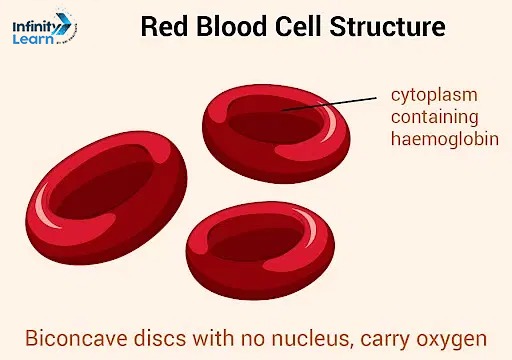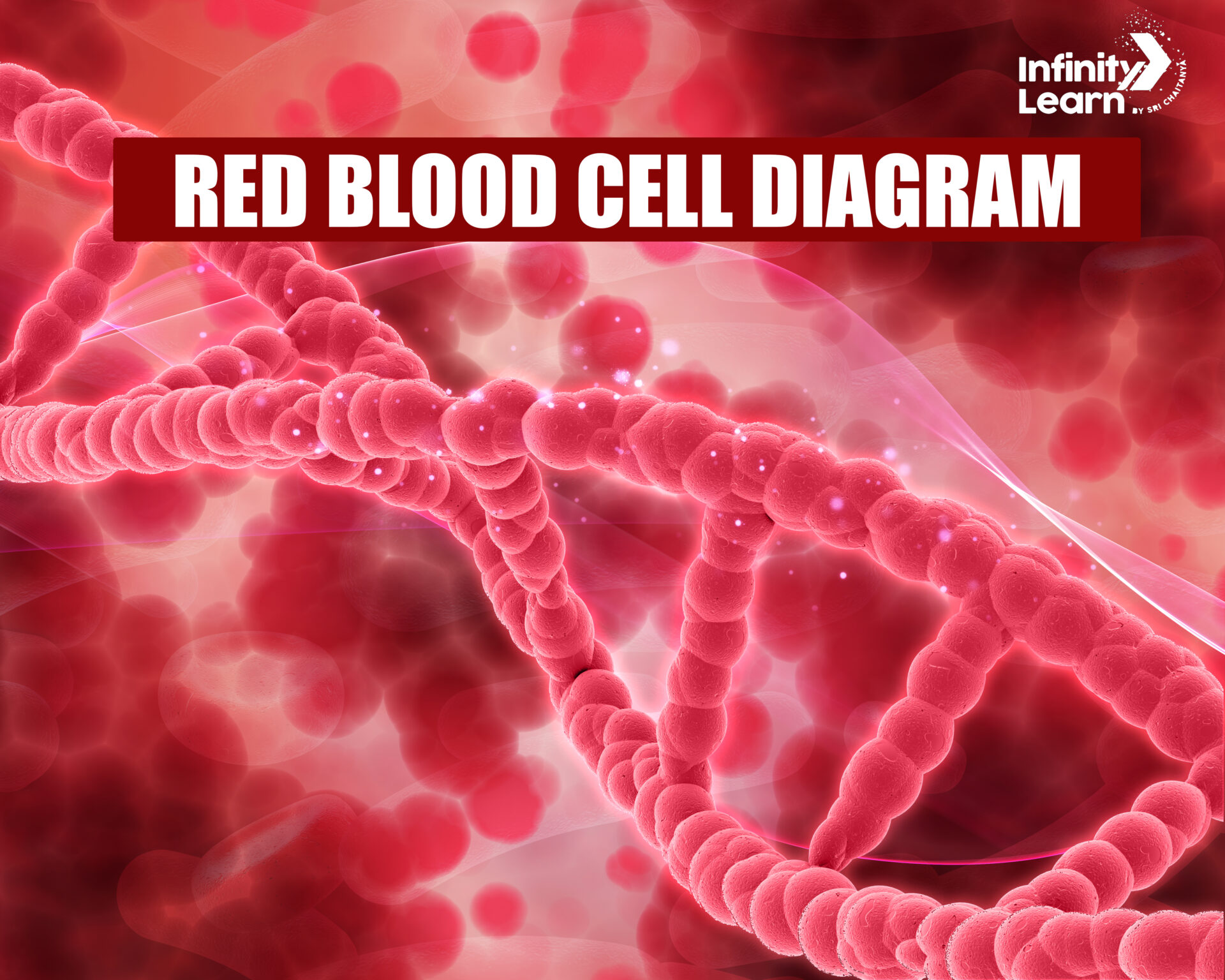Table of Contents
Red blood cells (RBCs) are essential components of blood, responsible for transporting oxygen from the lungs to the rest of the body and returning carbon dioxide for exhalation. Each RBC contains hemoglobin, a protein that binds oxygen. The primary function of red blood cells is to ensure efficient gas exchange, crucial for cellular respiration and energy production in the body.
Red Blood Cell- Structure and Shape
Red blood cells have a unique biconcave shape, which increases their surface area and allows for greater flexibility as they travel through narrow blood vessels. This shape is critical for their function as it aids in the efficient exchange of gases. The structure of RBCs is simple, lacking a nucleus and most organelles, which leaves more room for hemoglobin.

Red blood cells (RBCs), also known as erythrocytes, have a unique structure that enables them to perform their essential functions effectively. Here are the key structural features of RBCs:
- Biconcave Shape: RBCs have a distinctive biconcave disc shape. This means they are thinner in the center and thicker at the edges. This shape increases the surface area-to-volume ratio, allowing for more efficient gas exchange (oxygen and carbon dioxide) and flexibility to navigate through narrow capillaries.
- Lack of Nucleus: Mature red blood cells do not have a nucleus. During their development in the bone marrow, they lose their nucleus to make more space for hemoglobin, the protein responsible for carrying oxygen. The absence of a nucleus also provides more flexibility and deformability, which is crucial for their function.
- Cytoplasm: The cytoplasm of red blood cells is primarily composed of hemoglobin, which makes up about 33% of the cell’s weight. Hemoglobin is a complex protein with iron atoms that bind to oxygen, facilitating its transport throughout the body.
- Cell Membrane: The cell membrane of RBCs is highly flexible and contains various proteins that help maintain the cell’s shape and stability. It also contains glycoproteins and glycolipids that determine the blood type (A, B, AB, or O) of an individual.
- Size and Dimensions: Red blood cells are typically about 6-8 micrometers in diameter. Their small size and biconcave shape allow them to pass through the smallest blood vessels, ensuring efficient oxygen delivery to all tissues.
- Lifespan and Turnover: Red blood cells have a lifespan of about 120 days. After this period, they are removed from circulation by the spleen and liver, where they are broken down and their components are recycled.
Also Check: Biology Topics
Red Blood Cell Components
The main components of red blood cells include:
- Hemoglobin: The oxygen-carrying protein.
- Membrane Proteins: These help maintain the biconcave shape and flexibility.
- Cytoplasm: Contains hemoglobin and other minor components like enzymes necessary for metabolism.
Red Blood Cell- Types and Count
There are various types of red blood cells based on their age and function:
- Reticulocytes: Immature red blood cells.
- Erythrocytes: Mature red blood cells. The red blood cell count is a measure of the number of RBCs in a volume of blood, typically measured in cells per microliter. The normal range varies but generally falls between 4.7 to 6.1 million cells per microliter for men and 4.2 to 5.4 million cells per microliter for women.
Also Check: RBC Full Form
Red Blood Cells in Urine
The presence of red blood cells in urine can indicate various conditions. The normal range is typically up to 4 RBCs per high power field (HPF). Higher levels can indicate issues like infections, trauma, or kidney stones.
Red Blood Cell Diagram
A red blood cell diagram illustrates its biconcave shape and lack of nucleus, providing a visual representation of its structure, aiding in the understanding of its function and properties.

Red Blood Cell- Functions
Red blood cells (RBCs), also known as erythrocytes, perform several crucial functions in the human body:
- Oxygen Transport: The primary function of RBCs is to transport oxygen from the lungs to the tissues. Hemoglobin, a protein in red blood cells, binds to oxygen in the lungs and releases it in tissues where it’s needed.
- Carbon Dioxide Removal: Red blood cells also carry carbon dioxide, a waste product of cellular metabolism, from the tissues back to the lungs, where it is exhaled.
- Maintaining pH Balance: RBCs help maintain the acid-base balance (pH) of the blood. Hemoglobin within the cells binds to hydrogen ions and acts as a buffer to prevent blood from becoming too acidic or alkaline.
- Nutrient Transport: Although not their primary function, RBCs can also carry nutrients and metabolites between different parts of the body.
- Immune Function: RBCs can contribute to the immune response by transporting immune complexes to the liver and spleen for removal.
- Clot Formation: While platelets are the primary cells involved in clot formation, RBCs can become trapped in clots, helping to stabilize and reinforce them.
These functions make red blood cells indispensable for sustaining life, supporting various physiological processes, and maintaining overall health. Regular monitoring of RBC count and function through blood tests can help in diagnosing and managing different medical conditions.
Red Blood Cell Count
The RBC count is an important diagnostic tool, reflecting the number of red blood cells in a given volume of blood. It can help diagnose conditions like anemia, where the RBC count is low, or polycythemia, where the RBC count is high.
Also Check: Science Topics for Kids & Students
Red Blood Cell – Key Facts and Functions
Understanding the key facts and functions of red blood cells helps in comprehending their vital role in the body’s overall health and the mechanisms behind various medical conditions. Regular blood tests can monitor RBC count and function, ensuring timely medical intervention when needed.
FAQs on Red Blood Cell
what is the function of red blood cells
Red blood cells (RBCs) transport oxygen from the lungs to the rest of the body and return carbon dioxide from the tissues to the lungs for exhalation.
How to Increase Red Blood Cells Quickly
Consume foods rich in iron, such as red meat, beans, and leafy greens, and take iron supplements if necessary to boost red blood cell production.
What is the lifespan of a red blood cell
The average lifespan of a red blood cell is about 120 days.
What is the another name for red blood cells
Red blood cells are also known as erythrocytes
How many red blood cells are in the human body
An average adult human body contains about 20-30 trillion red blood cells.
How to decrease red blood cells quickly
To reduce high red blood cell counts, doctors may recommend phlebotomy, medications, or treating underlying conditions such as sleep apnea or heart disease.
How to increase low red blood cell count
To increase low red blood cell count, consume iron-rich foods, take iron supplements, and ensure adequate intake of vitamin B12 and folic acid.
Do red blood cells have a nucleus
No, mature red blood cells in humans do not have a nucleus.
How to increase red blood cells
Boost red blood cell production by eating iron-rich foods, ensuring sufficient vitamin B12 and folate intake, and taking iron supplements if needed.





